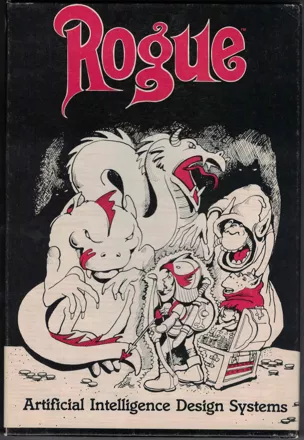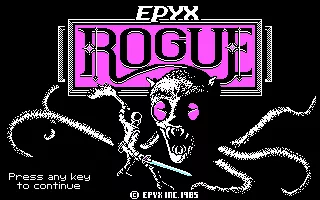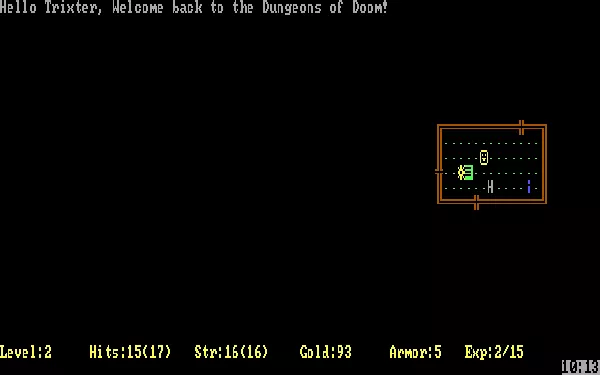Rogue
Description official descriptions
Rogue is a turn-based dungeon crawler in which the player controls an adventurer who must explore the dangerous Dungeon of Doom in order to retrieve the precious Amulet of Yendor and make it out alive. The player character starts on the upper-most level and slowly makes his way downwards.
The game uses ASCII characters to represent locations, items, monsters, and the protagonist himself. There are twenty-six different types of monsters, symbolized by their initial letters (e.g. L for Leprechaun). Monsters have different abilities and modes of attack. The dungeon and the items in it are randomly generated each time the player begins a new game. Each dungeon level contains a grid of three by three rooms and dead ends.
Levels get progressively more complex and maze-like, and monsters grow in strength the deeper the hero ventures into the dungeon. The player character can acquire better weapons and armor, gain experience points and level up. Should the protagonist perish in the dungeon, the player must restart the game anew.
Spellings
- ローグ - Japanese spelling
Groups +
Screenshots
Promos
Credits (DOS version)
19 People (5 developers, 14 thanks)
| Original Concept | |
| Adapted for the IBM PC by | |
| Significant design contributions by | |
| A Guide to Dungeons of Doom by | |
| Special Thanks |
|
| Public domain version of Rogue written by |
Reviews
Critics
Average score: 53% (based on 9 ratings)
Players
Average score: 3.4 out of 5 (based on 74 ratings with 7 reviews)
More playable than most classic RPGs
The Good
Well it's no BS, ASCII graphics and one can get the hang of the game pretty quickly I reckon. So it's top-down view, treasure hunting. Upgrading weapons and armour and making use of magic doesn't take too long. The game is arcade enough that you can do things on the run. I'd say that most games are enjoyable, though you can get unlucky sometimes and die early.
The Bad
Well frankly I don't see why you should have to start over when you die except that because the game designers want to be bastards. Basically if you're serious about completing this game you have to waste a lot of time replaying levels.
The Bottom Line
Well if you can put this game alongside Ultima and Wizardry as a classic RPG, then I think it's better because you can have a quick game of it and feel like you've done well and made progress.
DOS · by Andrew Fisher (697) · 2017
The Good
This game is great! as Free arcade puts it: living proof that graphics are NOT what makes a good game. the object is to retrieve the Amulet of Yendor, which has been stolen by a large group of Rogues and hidden in the 26th level of the dungeon of doom. along the way you will find and quaff potions, Wear rings and armor, and battle the Rogues.
While you do all this, you must keep from starving.
sounds hard, right? Right. plus, you can't just get the amulet and win, you must also leave the dungeon with at LEAST the amulet... and the hardest to keep item in the game, your life.
The Bad
This game is HARD! The deepest I ever went is level 8, only to get killed by a glitch!(?) however, it's got that addictive fun you can't resist! if you play it once, you can't help but play it more!
The Bottom Line
Get this game. period. it can be downloaded from DOSgames.com if you want it. and don't worry if you don't have DOS, it works on almost every operating system.
In fact, I'm using windows XP!
DOS · by Starstorm (1) · 2006
Ahhh. The quest for the... What Am I Searching for again?
The Good
Ahh, Rogue. The name alone brings forth memories of sitting in front of my 8088 PS/2 and wildly tapping the keys battling Aquators, Phantoms and Kestrals.
This game is great. One of the first real "graphic" adventures, it was a giant step forward from Infocom Interactive fiction. This game was also the granddaddy of "randomly generated" games, such as Nethack, that very few current games have yet to match.
The gameplay is very very simple. You start out entering the "Dungeons of Doom", and need to progress down through the dungeon to the 26th level to retrieve the Orb. Along the way you'll pick up magical blades, strange scrolls, wands, rings, staves, and food. You're character is portrayed by good ol SMILEY FACE. All the Monsters are represented by the letters A-Z (although you can't see "P", because P stands for Phantom and Phantoms are invisible :) You fight and move using the keypad, and you can pick up and drop items that you find during your adventure.
Being that Rogue: The Adventure Game randomly creates the dungeon as you progress through the game, it also randomly names spells. So if an enchant armore spell is "vof wifan que" in one game, you can be ABSOLUTELY POSITIVE it won't be the same the next time you play. Same goes with wands and potions. Wand types (i.e. silver, molybdenum, gold) and Potion types (green, turquiose, plaid) will also be different each time you play. So note-taking will have NO effect except if you take notes on the different ITEMS found in the game, not the descriptions.
The graphics are ANSI style graphics. Therefore, the best you would get is 16 colors and the entire ASCII extended character base to work from. Fortunately, the extended ASCII set has characters that look like walls, and the Monsters are provided by the Alphabet. The game will run on any PC, even PC's running Windows 98 (a miracle in itself)
The only sound available in 1983 was the good old PC speaker, and It just bleeped.
Control is very easy. The numeric keypad moves your character, and also attacks in the direction you press. Can't get any simpler than that. :)
The Bad
The game, although deceptively easy, is tough. I mean TOUGH. I have never reached the 26th level (so for me it is mere rumor... I believe that it goes as far down as the game want you to get :) so I have never recovered the orb.
Because of the game randomness, I've been killed on level 2 due to a lucky hit from a Hobgoblin, but I've also ventured to the 10th level only to be killed of by starvation.
Starvation sucks. Pure and simple. It's a matter of randomness if you get a lot of food or if you are continually fainting.
The Bottom Line
So to sum up the above review... It's random. It all depends on what the program gives you, that will determine how far you get in the game.
It's a fantastic game, don't get me wrong. You just have to catch the right time to play it. It all depends on the randomness :)
DOS · by Chris Martin (1155) · 2000
Discussion
| Subject | By | Date |
|---|---|---|
| Rogue in AUUG Newsletter Sept. '82 (Australian Unix Users Group) | Andrew Fisher (697) | May 10, 2023 |
| Game Group: Rogue Variants? | PCGamer77 (3157) | Jun 7, 2021 |
| Amiga version of Rogue for PC | Ardor | Mar 2, 2009 |
| Game port listing needs to be removed? | LepricahnsGold (142738) | Dec 13, 2008 |
| Public Domain or Commercial? | Indra was here (20749) | Nov 6, 2007 |
Trivia
1001 Video Games
Rogue appears in the book 1001 Video Games You Must Play Before You Die by General Editor Tony Mott.
Academic paper
A sophisticated mainframe-Rogue-playing AI, the "Rog-o-matic" (A Belligerent Expert System), was the subject of an academic paper written by Michael Maudlin, Guy Jacobson, Andrew Appel and Leonard Hamey of Carnegie Mellon University and presented at the Fifth Biennial Conference of the Canadian Society for Computational Studies of Intelligence, London Ontario, May 16, 1984.
This paper can be read (and its behavior diagrams ogled) here.
Copy protection
The commercial Rogue versions didn't fare too well, as lots of pirated copies existed. The later DOS versions were copy protected (starting at the latest with V1.48 published by Epyx), in an interesting way. You could actually play a pirated copy, but if you did, you suffered six times the normal damage from monster attacks -- which quickly ended an already pretty hard game, it was hard to even get to level two. On the tombstone, you could then read the evocative message:
*REST IN PEACE
Software Pirate
killed by
Copy Protection Mafia*
Development
Rogue was first developed in 1980 on PLATO mainframes (first at Santa Cruz, then Berkeley), where it was extensively beta-tested by fellow Computing Science students. (Three months after moving to Berkeley, more compute cycles were used playing Rogue than running any other program.) The game's creators eventually calculated that their little diversion had used up approximately "a billion and a half dollars of compute time in Silicon Valley". Your taxpayer dollars at work!
Different versions
In keeping with the game's U.C. Berkeley roots, a public domain version of it was distributed with version 4.2 of the university's popular flavour of Unix -- the Berkeley Standard Distribution, or BSD. This ended up ensuring an enduring fondness for the game among a wide and international fanbase.
In 2006, Donnie Russell released a version called ClassicRogue, which features a graphical title screen optional mouse control, and sound effects.
When Epyx re-released the DOS version of Rogue in 1985, the main addition was a graphical title screen. The developer of this version, Jon Lane, one of the original developers of Rogue, didn't seem to have liked it: In the source code, the function to display that image is called "epyx_yuck"...
Programming
Written in a very early version of Lattice C (version 1.02, to be exact).
Information also contributed by FatherJack. [General Error](http://www.mobygames.com/user/sheet/userSheetId,54276/), and [Pseudo_Intellectual](http://www.mobygames.com/user/sheet/userSheetId,49363/).
Analytics
Upgrade to MobyPro to view research rankings!
Related Sites +
-
A brief history of Rogue
The history of this seminal game written by one of its creators, Glenn R. Wichman. -
Donnie Russel's Webpage
Home Page of the author of the Rogue ports to Windows and Linux, ClassicRogue and TileRogue, as well as a port for the Gameboy Advanced called AGB_Rogue -
Old CRPGs
Another page hosting old executables and source code for Rogue its derivatives. -
ROG-O-MATIC: A Belligerent Expert System
The paper that describes the ROG-O-MATIC expert system, an early AI experiment to let computers play Rogue. Quite successful, as it seems! -
Rogue @ Epyx Shrine
Screenshots of the various versions and an interview with Glenn Wichman, co-creator of the original "Rogue". -
Rogue Restoration Project
Official site for all Rogue games variations -
Rogue: The Adventure Game
product page for the iPhone version -
Roguebasin wiki
Information and history of the game -
The CRPG Addict: Rogue
Posts about the game at The CRPG Addict blog. -
The Dungeons of Doom
Featuring the history of rogue, a lot of tips and hints, and the sources for the original PC Rogue. -
The Roguelike Archive
Source code and executables for many systems of many different Rogue versions and other roguelike games. -
zRogue
Gevan Dutton's 1998 Z-code abuse port of Rogue can be played online through your web browser.
Identifiers +
Contribute
Are you familiar with this game? Help document and preserve this entry in video game history! If your contribution is approved, you will earn points and be credited as a contributor.
Contributors to this Entry
Game added by Kalirion.
Atari 8-bit added by JRK. GP2X, GP32 added by 666gonzo666. Nintendo Switch added by Kam1Kaz3NL77. PC-88 added by Infernos. Roku added by firefang9212. Windows added by Sciere. Macintosh added by Kabushi. Commodore 64, Amstrad CPC, Amiga added by Martin Smith. Atari ST added by ZZip. Android, Mainframe added by Pseudo_Intellectual. Linux added by General Error. PC-98 added by vermilion1. Antstream added by lights out party. ZX Spectrum added by voidoid. TRS-80 CoCo added by L. Curtis Boyle.
Additional contributors: Trixter, Sciere, Alaka, Silverblade, Pseudo_Intellectual, General Error, Havoc Crow, CalaisianMindthief, Rik Hideto, Gouken.
Game added June 23, 2000. Last modified August 10, 2024.



















